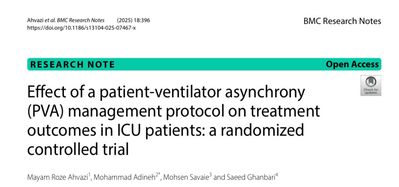📜 Journal Club: Effect of a patient-ventilator asynchrony (PVA) management protocol on treatment outcomes in ICU patients: a randomized controlled trial
By: BETINA SANTOS TOMAZ, FISIOTERAPEUTA - 10/09/2025 18:14
🩺 Paper of the Week
The featured paper was published in September 2025 in BMC Research Notes, led by Ahvazi et al. from Ahvaz Jundishapur University of Medical Sciences (Iran).
The study comes from a nursing and critical care research group focused on simple and cost-effective strategies to improve mechanical ventilation management in critically ill patients.
🎯 Objective
To evaluate whether implementing a structured protocol for patient–ventilator asynchrony (PVA) management could improve clinical outcomes in invasively ventilated ICU patients.
✍️ Methods
- Design: Single-center, simple-blind randomized clinical trial
- Sample: 66 patients (33 intervention × 33 control)
- Inclusion criteria: 15–65 years old, ventilated in assist-control mode, APACHE II between 30–40
- Intervention: Systematic PVA assessment every 2 hours with protocol-based corrections (sedation titration, trigger/flow/VT/PEEP adjustments, or mode change)
- Control: Usual care, with asynchronies detected incidentally. Interestingly, the most common response in this group was to increase sedation rather than address the underlying cause — sounds familiar in many ICUs?
- Primary outcome: Duration of mechanical ventilation
- Secondary outcomes: ICU length of stay, weaning success, ICU mortality, and self-extubation
📊 Key Results
- Mechanical ventilation duration: 12.6 ± 6.1 days (intervention) vs. 18.0 ± 4.2 days (control), p < 0.001
- ICU length of stay: 14.3 ± 5.1 days vs. 22.6 ± 5.8 days, p < 0.001
- Weaning success: Significantly higher in the intervention group (p < 0.001)
- ICU mortality: No significant difference (18.2% overall, p = 0.202)
- Self-extubation: No difference (p = 0.787)
- Most common asynchrony: Ineffective efforts (~68%)
💪 Strengths
- Randomized design with systematic asynchrony monitoring
- Clinically applicable: simple, bedside-friendly protocol based on waveform interpretation
- Clinically relevant results — shorter MV duration and ICU stay
⚠️ Limitations
- Single-center study with small sample size
- Partial blinding — care team aware of allocation, potential performance bias
- PVA detection relied only on visual waveform analysis, with no automated tools or advanced physiology metrics
- No difference in mortality or self-extubation — likely underpowered for these endpoints
💡 Clinical Implications
This study reinforces that structured and proactive management of patient–ventilator asynchrony can meaningfully reduce ventilator days and ICU length of stay — outcomes of major relevance in critical care.
Future multicenter studies with larger samples and integrated automated detection tools could validate and expand these findings.
📢 For the Xlung Forum
This paper provides practical evidence that actively monitoring and managing PVA can accelerate weaning and reduce ICU workload.
👉 What do you think, Xlung community?
Is it feasible to implement scheduled PVA screening protocols in Brazilian ICUs?
Does your team already use something similar?
🔗 Read the full paper: BMC Research Notes — Ahvazi et al., 2025
To add an answer on this topic and read the replies...
You must have a valid and active xlung subscription
If you are already a subscriber, please Login at the top of the page, or subscribe now

